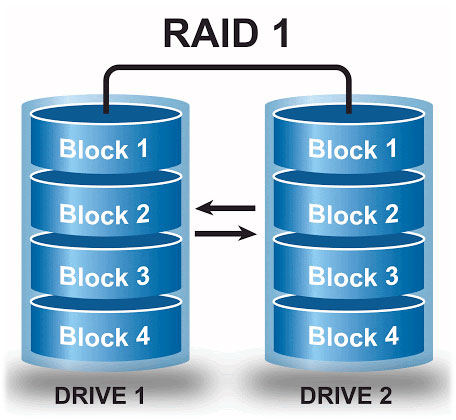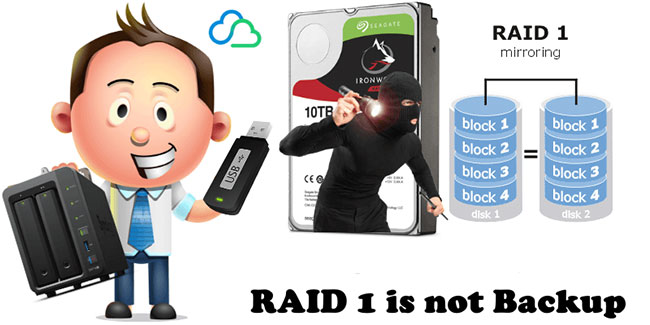What is RAID 1? How to use RAID 1 on a Mac
RAID 1 is one of many RAID levels directly supported by OS X and the new macOS. RAID 1 creates an exact (copy) copy of the data on the storage drive into one or more additional drives. RAID 1 requires a minimum of 2 drives. Additional drives in the RAID 1 set increase overall reliability equal to the power of the number of drives in the RAID 1 set.
An example of the increased reliability, provided by the RAID 1 set of cloned drives, can be illustrated with a set of 2 identical drives. Suppose the failure rate for any drive is 10% for its expected life cycle. The chance that both drives will be corrupted at the same time will be reduced to only 1%. If a third drive is added to the RAID 1 set, the result is a chance that the problem will be reduced to less than 1%.
RAID 1 space
 The total disk space available for Macs is equal to the size of the smallest component in the RAID 1 set
The total disk space available for Macs is equal to the size of the smallest component in the RAID 1 set The total amount of disk space available for the Mac is equal to the size of the smallest component in the RAID 1 set. For example, if you have a RAID 1 set of 500GB drives and 320GB drives, the total available capacity for the machine Mac will be equal to 320GB. The additional space available on the 500GB drive is wasted and not available for use. Although RAID 1 allows the use of disks of different sizes, it is clearly not beneficial to do so.
Ideally, the RAID 1 set must consist of drives of the same capacity and (if possible) from the same manufacturer, as well as the model. Although there is no requirement to force the drives to be identical, it is the best way to take advantage of RAID.
The array to be copied is not a backup
 The array to be copied is not a backup
The array to be copied is not a backup A RAID 1 array should not be confused with data backup. RAID 1 specializes in resolving hardware errors and cannot do anything by itself to recover files that you deleted by mistake, from application failure or other problems. RAID 1 is an exact copy, so as soon as a file is deleted, it will disappear from all component drives in the RAID 1 set.
With the advent of OS X El Capitan, the ability to create and manage RAID arrays has been removed. Although Terminal can be used to work with RAID arrays, an application such as SoftRAID Lite can easily perform the RAID functions included with Disk Utility.
When macOS Sierra was introduced, the ability of Disk Utility to create and manage RAID arrays was back.
You should read it
- What is raid? Common types of RAID compare their similarities and differences
- How to Disable RAID
- How to switch from RAID to AHCI without reinstalling Windows 10
- Learn about RAID
- How to fix the black screen of the Raid game
- Building backup disk system (RAID)
- Unsolved mysteries in World War 2
- CrossFire hack software contains countless viruses
May be interested
- CrossFire hack software contains countless viruses
 nearly 10,000 accounts were blocked after a week vtc game opened the 'iron hand' campaign to handle gamers using fraudulent software when playing crossfire (raid).
nearly 10,000 accounts were blocked after a week vtc game opened the 'iron hand' campaign to handle gamers using fraudulent software when playing crossfire (raid). - How to enter BIOS Windows 10 Asus, Dell, HP, Acer
 normally if you use a windows 10 device, the basic program will work automatically. however, sometimes you may still need to enter the win 10 bios to solve problems, enable or disable features such as virtualization, raid arrays, secure boot, and adjust memory and processor settings. advanced.
normally if you use a windows 10 device, the basic program will work automatically. however, sometimes you may still need to enter the win 10 bios to solve problems, enable or disable features such as virtualization, raid arrays, secure boot, and adjust memory and processor settings. advanced. - Promise Pegasus3 R8 - A promising upgrade
 what makes promise pegasus3 an indispensable tool for professional filmmakers and youtubers?
what makes promise pegasus3 an indispensable tool for professional filmmakers and youtubers? - Instagram account of a series of famous stars hacked and used as a means of fraud
 the popular instagram account of the raid campaign after a period of cooling down has continued to heat up over the past few days.
the popular instagram account of the raid campaign after a period of cooling down has continued to heat up over the past few days. - DuraBook D14 E-Series protects data safety
 gammatech's durabook d14 e-series laptop features a storage capacity of up to 1tb and data protection mode options through raid setup
gammatech's durabook d14 e-series laptop features a storage capacity of up to 1tb and data protection mode options through raid setup - How to Find a Village in Minecraft
 the village is a unique structure created in the game minecraft and is the residence of many villagers. there are many farms here for players to get food and many chests to store items. not to mention the fact that you will see a lot of houses and be able to barter with the villagers. whether you intend to stay, visit, or raid, here's how to find a village in minecraft!
the village is a unique structure created in the game minecraft and is the residence of many villagers. there are many farms here for players to get food and many chests to store items. not to mention the fact that you will see a lot of houses and be able to barter with the villagers. whether you intend to stay, visit, or raid, here's how to find a village in minecraft! - Backup data: directly on the system or apply the Cloud model
 the process of backing up data is extremely important when using or managing any computer system. so far, we often apply basic backup methods such as using external hard drives, raid, and writing data to cd / dvd ...
the process of backing up data is extremely important when using or managing any computer system. so far, we often apply basic backup methods such as using external hard drives, raid, and writing data to cd / dvd ... - Minecraft: How to Raid the Ancient City Safely
 ancient cities in minecraft are extremely dangerous, but very fun to explore.
ancient cities in minecraft are extremely dangerous, but very fun to explore. - Methods to expand storage memory for computers quickly
 when a 'low disk space' warning appears on your computer, this means that your disk space is extremely low. you need to delete some things to free up space, but in fact you can't give up anything on your computer because it's all important data.
when a 'low disk space' warning appears on your computer, this means that your disk space is extremely low. you need to delete some things to free up space, but in fact you can't give up anything on your computer because it's all important data. - Can Pokemon Go be played on a computer? The answer is yes!
 by software emulation and additional software to support positioning, we can completely play pokemon go right on the computer, comfortable catching pokemon without worrying about running out of battery when playing as on the phone.
by software emulation and additional software to support positioning, we can completely play pokemon go right on the computer, comfortable catching pokemon without worrying about running out of battery when playing as on the phone.










 Fixed a bug where FileVault cannot be enabled on Mac
Fixed a bug where FileVault cannot be enabled on Mac How to fix AirDrop problems on Mac
How to fix AirDrop problems on Mac How to use Hot Corner on Mac
How to use Hot Corner on Mac How to use Head Pointer on a Mac
How to use Head Pointer on a Mac How to share a Mac screen with Messages
How to share a Mac screen with Messages How to restart the Touch Bar on macOS
How to restart the Touch Bar on macOS